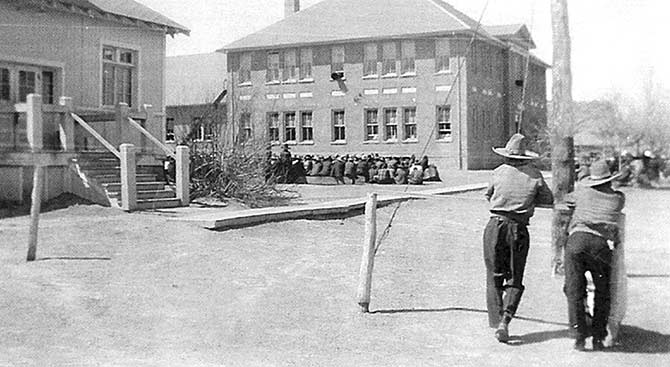
50 Years Ago: Medicine man murdered because of ‘hexing’

(Courtesy photo - Crownpoint Historical and Cultural Heritage Council) A meeting is held in the 1920s at the Pueblo Bonito Agency Boarding School in Crownpoint. The kindergarten building (later town hall) is on the left.
It was a tragedy of unbelievable proportions, according to one tribal police official — the murder of a Navajo medicine man.
It occurred near Crownpoint on Aug. 6 but it wasn’t reported to the public until almost three weeks later as Navajo Nation Police and FBI agents interviewed more than 100 people who had attended a Nidáá’ that night.
The victim was Fran Chiquito, 78, a well-respected medicine man who died shortly after midnight after he had been kicked in the face and head several times while he was lying on the ground.
Two Gallup men would eventually be arrested for the crime, one of whom would claim he had no choice but to murder the man because he was “hexing” his family. All he did, he said, was save his family.
Police officials, however, put it down to just another fight that got out of hand.
This defense — “saving my family” — resonated in some quarters in the remote parts of the reservation and the case would keep getting a lot of attention in area newspapers throughout 1967 and 1968.
In other news, this was a big week for Navajo families in the small community of Alamo. Fifty years ago, they got electricity delivered to their homes for the first time.
It’s hard to imagine that in 1967 there were patches on the Navajo Reservation where entire communities were still without electricity but news accounts indicated that while reporters were expecting cheers and yells when the switch was thrown giving the community residents electricity for the first time, what they got was “stoicism” from the 700 or so Navajos who attended the ceremony when the electricity was turned on.
The only place that had electricity up to then was the old Alamo Day School, which had a gasoline-powered generator that provided electricity for part of the day.
Thanks to a grant made possible by U.S. Vice President Hubert Humphrey, some 100 homes on the Alamo Reservation had been wired for electricity. Some of the homes had been wired several months before and families had to wait while electrical lines were finally brought to the community.
There were officials from the Rural Electric Administration, the federal agency that wired the homes, at the ceremony and Humphrey spoke by phone, saying that this was the first step in bringing modern conveniences to the people of Alamo.
With the homes now hooked up for electricity, the next step was to bring in phone service. An official for the U.S. Forest Service was there to sign up volunteers who wanted to be part of the area’s forest fire-fighting group.
Alamo residents were not recruited in the past because there was no way of communicating with them quickly if they were needed but now with phone service, everything had changed.
Internally at the Navajo Times, the big question on everyone’s minds was who was going to be named managing editor and how soon.
It had been almost two months since Chet Macrorie had stepped down as managing editor after members of the Navajo Tribal Council had approved a 1967-1968 budget that eliminated his position.
Navajo Tribal Chairman Raymond Nakai said discussions had been going on about who to appoint to the position but since there was no money set aside for a managing editor, putting someone in there was impossible a this time.
Nakai said he had a couple of vacancies on his staff and he was wiling to transfer one of them over to the Navajo Times if someone suitable could be found to run the paper.
The problem was, at least from the standpoint of Macrorie, who said later he was watching to see what would happen with the paper, was that if Nakai used one of his positions, the perception would be that the person hired would be reporting to Nakai and that wasn’t a terribly good idea.
The perfect solution would have been, of course, to find a Navajo who had the experience and the qualifications to run the paper but no one expected to find someone with those kinds of credentials in 1967. And if there was someone with the writing and managerial skills necessary, they would find greener pastures and a much larger paycheck working for Nakai.
Logically then the new managing editor would be a non-Indian but Nakai questioned putting such a person in the position because of fears he would take the paper in the wrong direction politically and no one wanted that.
Besides, the paper seemed to be doing all right with Nakai’s assistants running the paper and deciding what stories would be featured.
To read the full article, pick up your copy of the Navajo Times at your nearest newsstand Thursday mornings!
Are you a digital subscriber? Read the most recent three weeks of stories by logging in to your online account.








 Highway 264,
Highway 264, I-40, WB @ Winslow
I-40, WB @ Winslow